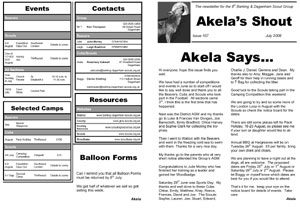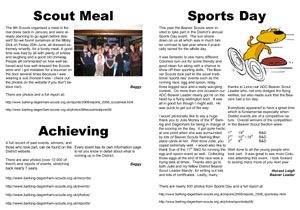
Introduction
The 9th B&D produces its own monthly Group newsletter called Akela's Shout. I decided to start producing a regular newsletter after Akela and I began handing out sheets/slips each week with details of the upcoming events. Instead of having to produce many small slips of paper each month detailing the dates and times of church parade etc. I decided to place them all in a regular newsletter. This has the advantage that it is only handed out once per month and being a regular 'major' occurrence the parents expect to receive all the relevant information on the first Tuesday in the month. That way there is less chance of the Cubs losing the information by the time they get home.
Once we started the newsletter we realised how useful it could be to impart information about the Group in general. Instead of a simple sheet of paper listing dates and times we can inform the parents and younger members about how events turned out. Each time we have an event or camp we can put an interesting report on what happened into the newsletter for all to read. This gets the kids and parents involved more and they get to see exactly how much the Scout Group is doing. It also gives the kids a chance to write a piece themselves and see it in print.
The newsletter has been going for over 10 years now and has grown to include a variety of material.
Yeah, but does anyone read it?
Well that is exactly what I asked myself after the newsletter had been running for nearly a year. One of the parents suggested that I put a slip to fill in at the end of the newsletter to gauge the response. So I designed a short 'tick the box' type slip asking 4 simple questions. The parents had to complete the form and sign it, returning it as soon as possible. The response was not too bad. All of the Cubs returned the newsletter (not surprising as I am a Cub leader so I know whether they have took the newsletter or not and I speak to their parents), most of the Beavers did too although some of the Scouts did not return the form. There was also a short section asking for their ideas and thoughts. There were no bad comments (well none on the slips that were returned anyway!). There were 3 parents who asked if they could know about forthcoming events a bit sooner (this I resolved byy printing the dates for the entire year in one issue at the beginning of each year as well as detailing events 2 or 3 months in advance each issue). The only other comment about Akela's Shout was "..she does, LOUDLY & a lot!".
Over the years the kids have grown up in the Group getting used to receiving the newsletter on the first Tuesday of every month and the parents are grateful for the constant updated information and handy calendar. Today all the members of the Group read it every month and are fully aware of its uses.
Of course you will never be able to completely rely upon a monthly newsletter for details of events. Even now we still occasionally give out the odd sheet telling people when and where to meet on the Tuesday before. This is unavoidable as leaders as a general rule of thumb never know where or when or how an event is until about 2 days before!
Joking aside don't rely upon a newsletter to talk to the parents. Get out there and chat to them yourself. Nothing beats having an actual real life conversation to clear up problems and arrange simple details.
What does it look like?
 The newsletter underwent a (much needed) redesign at the beginning of 2001 and 2002, and again a few years ago.
The newsletter underwent a (much needed) redesign at the beginning of 2001 and 2002, and again a few years ago.
The format is a relatively simple one, based on a newspaper. Fancy gimmicks and complicated pictures are kept to a minimum and simple typesetting rules are obeyed to make it easy to read. The 2001 version usually ran to 2 or 3 pages but the latest version is almost always 4 A5 pages printed double sided on a single sheet of A4. The important sections (and the original impetus for making the newsletter) are the upcoming events, news and information.
The logo and issue number/date are under the main logo to easily identify the newsletter. I'm sure parents among you will be aware of just how many pieces of paper their children bring home, hopefully it is a little harder to lose the newsletter now. Important information can be clearly marked with a decent headline or perhaps an attention grabbing box or marker.
The main content always begins with a short editorial from Akela. She will normally run through the news items in brief and thank all those who need to be thanked (note the picture of 'Akela' on the headline to identify the author)
Upcoming events are now detailed in the calendar or in their own little section. Events for the next month at least are included and are divided according to sections (Beavers or Cubs etc, Adults, Fundraising, Camps). This means that you can pull the back page off and pin it up. When the newsletter is a single sheet this information is split up into group sections and posted in an easy to read grey box by date.
The next major piece are all the news and information items. Any important information will be mentioned on the front page.
 On the next few pages is where we can report on recent events and perhaps more importantly, give the parents any news regarding the group. If the subs are going up, fundraising ideas, details on social events and much more needs to be imparted to the parents on a regular basis. It also gives the leaders, kids and parents a chance to reflect and report on happenings within the Group. We have had reports about camp, competitions, views on behavior, a look at the program, a piece on what it means to be a leader and more. It is not always about Scouting. As I keep saying to the kids if you want to write a piece and it is half sensible I will print it. We have had a few about going on holiday to America and school trips. There are often articles such as 'Choosing the right boot' and '101 things Skip forget to tell me' as well as jokes and cartoons.
On the next few pages is where we can report on recent events and perhaps more importantly, give the parents any news regarding the group. If the subs are going up, fundraising ideas, details on social events and much more needs to be imparted to the parents on a regular basis. It also gives the leaders, kids and parents a chance to reflect and report on happenings within the Group. We have had reports about camp, competitions, views on behavior, a look at the program, a piece on what it means to be a leader and more. It is not always about Scouting. As I keep saying to the kids if you want to write a piece and it is half sensible I will print it. We have had a few about going on holiday to America and school trips. There are often articles such as 'Choosing the right boot' and '101 things Skip forget to tell me' as well as jokes and cartoons.
All column's have author acknowledgment and each leader has a small graphic to identify them as the author.
Every month contact details are included on the newsletter. This is always on the back page for easy access. This includes name, Scouting name, position, address, phone number and email for the main section leaders. We also include important local web address's each time.
I will also use the newsletter occasionally as a way of teaching the Scouts. In one issue for instance we included a 'free copy' of Get Knotted, a one page piece on some common knots, how to tie them and what they are used for (in colour as well!). In fact almost every month now there is an informative piece, whether it be on knots, saints or how Scouting is in other countries.
Occasionally we will have a competition or some fun piece like 'Guess the Lyrics'. Winners always receive a small reward (usually something like a chocolate bar).
Ok. How do I go about making them?
Right. This is the bit where you start out making a 5 minute newsletter and end up spending every spare minute of your time producing a journalistic masterpiece.
With the original newsletter I started out by using the newsletter template with Microsoft Word 6.0. This should enable you to knock out a simple newsletter in the shortest possible time. Simply load up one of the templates that appeals to you, change a few details and you will have a functional issue in time for the next pack night. The advantage of using Word is that it should be fairly 'idiot- proof' if you are remotely familiar with word processors. Word will take care of the basic layout and add extra pages etc. as you go. Also being a Word .doc your newsletter should be easy to print and pass around.
After using Word for a good few months I began to get a little frustrated with it. It was never intended as a Desk Top Publishing program and it shows the moment you try to do something fancy. I wanted to fiddle with the title and headers, add in a few pictures and put a header and footer onto each page (to show the issue no and page no along with a URL and email address). This means you will have to start fiddling with frames and such like. Inserting pictures and putting a frame round them is fairly painless but when you start messing with the basic layout things start to go wrong. Lines slip down, the title shifts on a bit, that carefully placed rule won't match up for love nor money. You find yourself flitting between the different views in word trying to work out what is going wrong. Another problem is that Word .docs are not exactly the smallest file size format in the world.
It was at this point that I gave up and switched over to using Microsoft Publisher and Adobe Acrobat (although it does hurt the wallet a bit, no, a lot!). After giving up trying to convert the .doc file I started from scratch and used Publisher to design an 'identical' template newsletter. And with the new look newsletter I modified one of the built-in templates using the wizards and content bar.
Now with Publisher, playing about with the layout and graphics is a lot simpler. Being a proper DTP program I can move and fiddle with things with ease, the program doing the lions share of the rearranging and formatting behind the scenes. I can position extra bits with precision and most importantly see exactly what I am doing and what it is going to look like in the end. Now the only trouble with using Publisher is that not everyone actually has it (i.e. Akela actually does the printing of the newsletter from work - don't all scout leaders?) and even if they did you need a 1Gb SparQ disk to transfer it across. Ok, OK a slight exaggeration. You know what I mean though, a typical newsletter .pub file can run from 500 K to a few megabytes depending upon content. Now I quickly realised I had made a mistake and had been wasting my time until my brother came to the rescue. The answer was Adobe Acrobat. If you can get access to this little beauty (e.g. at work or college) then you can convert your Publisher (or indeed almost any program that can 'print' to a printer) into a .pdf format. This basically works by pretending to be a printer. You print to the Distiller and it converts it into a .pdf.
The .pdf format is an excellent piece of kit enabling you to publish complex documents along with pictures, colours etc. all as they originally appeared. It has three 'killer' points
It retains the original formatting like a dream. What you print is what you get.
The file size is tiny compared to almost any other format due to compression.
Almost anyone can read them. The Adode Acrobat Reader program is free and easily available. What's more, most people using browsers now have this 'upgrade' built in so you can read straight from the web.
A good example is the newsletter I did initially. It started life as a 2.2 Mb publisher file and ended up as a 75 kb pdf!
Don't worry too much if you cannot afford the Adobe version. There are now many alternative 'pdf printers' that you can download and act as a basic printer driver. Printing to this virtual printer creates a pdf file. However nothing can beat the orginial full Adobe version for messing about with pdf files, but if all you want to do is create them then perhaps a cheaper alternative would suit you better. However, there are many different programs out there and I would always recommend a free program for someone to try things out with. Take a look at the Useful Programs list on the GLNE site. All those programs are high quality, safe to use and free!
